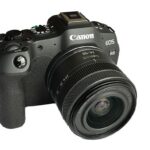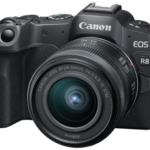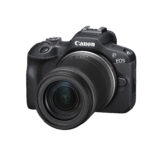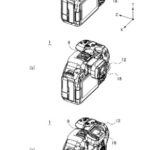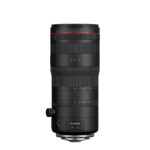My, how it has evolved. In 1989 Canon released the venerable – some would say landmark – EOS 1, a 35mm single lens reflex camera. Then in 2001, everything changed and the 1 became the 1D, a digital version of the EOS 1, and it was still a benchmark.
In my particular field, motorsport, 1Ds were everywhere, and anyone who was a published rev head snapper would own at least one. Certainly with my Canon XL1 camcorder, I was the odd one out!
But now we have the Canon EOS R3. So, as a replacement – sort of – for the 1D, how does it shape up?
Description
The first thing you notice is that despite a magnesium alloy frame and rubberized body, this camera is weighty. My test model came with a 50mm lens, and that combo weighed almost as much as my Blackmagic Pocket Cinema Camera 6K Pro WITH a Smallrig cage AND an Aputure AL-M9 light attached!
Have no fear though, as the ergonomic wizards, realising this, put not one but two hand grips on the R3 so that no matter you are holding it horizontally or vertically, there is sufficient holding power.
Of course, the heart of any digital camera is its sensor (some argue and say it’s the glass baby, the glass, but that’s another story). The EOS R3 has a full frame CMOS sensor with 24.1 resolution. The image ratio is standard 3:2 35mm and naturally, all this is held together by the tried-and-true Canon DIGIC X processor.
As you’d expect from a camera of this stature and pedigree, image stabilisation is built into the body with, depending on the lens used, up to 8 stops of shake.
Moving right along, we now look at the autofocus options, and the word that springs to mind is “impressive”. The Canon engineers have really stepped up to the plate here as along with all the other “normal” AF functionality you’d expect, the R3 sports an updated version of a unique Canon piece of magic called “Eye Control AF Technology” which is a fancy pants way of saying that camera will focus where you are looking.
It was in the EOS 1D Mk3, but from a mate (Ross Gibb from Ross Gibb Photography) who has both an 1D Mk3 and on the R3 he says it is vastly improved.
The immediate scenario that springs to mind for me harks back again to my motorsport shooting. In that game, you learn the ability to have one eye on the viewfinder and the other looking out – along with the tell-tale sound of tortured tyres – for some mishap or other. With this new technology, theoretically, you can simply swing the camera toward the source of the sound and never have to refocus manually.
But in practice, Ross says in the field, it is not yet totally reliable – and besides it would make it all too easy!
You can use the 3.2” LCD touch screen for focus too. It’s a vari-angle screen meaning it swivels and lifts allowing viewing from many angles.
 The rear of the body is amply populated by buttons and dials for the various control options, as is the top of the camera, and the ergonomics are superb. Even with my currently somewhat gammy right wrist, I could reach all controls easily without stress, and despite the weight of the R3, it actually doesn’t FEEL heavy in operation.
The rear of the body is amply populated by buttons and dials for the various control options, as is the top of the camera, and the ergonomics are superb. Even with my currently somewhat gammy right wrist, I could reach all controls easily without stress, and despite the weight of the R3, it actually doesn’t FEEL heavy in operation.
The Canon EOS R3 also doubles up as an impressive communications device. Built in is 802.11ac Wi-fi, Bluetooth 5, USB C, ethernet and even a GPS. Ross Gibb tells me that in a real situation, using the app (Android, iPhone or iPad) is all you need to get the images off the CFAST / SD cards (there are two slots).
 You can shoot in either JPG, HEIF or RAW at up to 12 fps mechanical and 30 fps electronic, with ISO speeds from 100 to 102,400 and you have 24.1 megapixels to play with allowing up to 6000 x 4000 pixel images in RAW mode.
You can shoot in either JPG, HEIF or RAW at up to 12 fps mechanical and 30 fps electronic, with ISO speeds from 100 to 102,400 and you have 24.1 megapixels to play with allowing up to 6000 x 4000 pixel images in RAW mode.
If you are into the video side, there is also HDMI and 3.5mm headphone and mic jacks. Shooting is possible in 6K at 60p, 4K at 120p and full HS at 120p.
Canon says battery life should be good for up to 800 shots which is certainly impressive in itself. In video mode, this would very much depend on the shooting mode used of course.
Image Quality
In a word, brilliant. Cannot fault it. That is all there is to say about that. And that’s why, if you are a pro, you’d buy this camera. Because make no bones, unless you are an amateur with a lazy $8.5K hanging around, that is who this camera is aimed at. The person that doesn’t look at the price per se, but at the whole package of image quality, reliability, functionality and ergonomics.

Conclusion
Whilst I was not there (sadly) I can think of no better test of a camera of this calibre than in its natural habitat; the conditions at the Bathurst 1000 last weekend were brutal, with rain, mud and everything else you can think off thrown at the photographers. And yet Ross Gibbs’ EOS R3 (he uses L series lenses with an adaptor) he says, performed without missing a beat.

That is testament in itself methinks.


